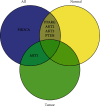PPARG and the PTEN-PI3K/AKT Signaling Axis May Cofunction in Promoting Chemosensitivity in Hypopharyngeal Squamous Cell Carcinoma
- PMID: 38505269
- PMCID: PMC10948231
- DOI: 10.1155/2024/2271214
PPARG and the PTEN-PI3K/AKT Signaling Axis May Cofunction in Promoting Chemosensitivity in Hypopharyngeal Squamous Cell Carcinoma
Abstract
It has been demonstrated that PPARG may interact with the PTEN-PI3K/AKT pathway, contributing to its involvement in the chemotherapy treatment of hypopharyngeal squamous cell carcinoma (HSCC). However, the underlying mechanism remains largely unknown. In this study, gene expression profiles of 17 HSCC patients, comprising 8 chemotherapy-sensitive patients (CSP) and 9 chemotherapy-nonsensitive patients (CNSP), were collected and analyzed to investigate expression patterns, correlations, influencing factors of the PPARG-PTEN-PI3K/AKT pathway, and its role in regulating chemosensitivity. The results revealed significantly increased expression (p < 0.04) of AKT1, AKT2, AKT3, PIK3CA, PPARG, and PTEN in the CSP group compared to the CNSP group. Specifically, AKT2 exhibited significant overexpression in tumor tissue (p = 0.01), while AKT2, AKT3, PPARG, and PTEN displayed significant increases in normal tissue (p ≤ 0.04). Positive correlations (R ∈ [0.43, 0.71], p < 0.014) were observed between PIK3CA, AKT1, AKT2, AKT3, and PTEN, with AKT2, AKT3, and PTEN also showing significant correlations with PPARG (R ∈ [0.35, 0.47], p < 0.04). Age, gender, and disease stage had no influence on PPARG, PIK3CA, and PTEN expression, but they may affect AKT expressions. Pathway analysis revealed that PPARG may interact with the PTEN-PI3K/AKT signaling pathway, playing a crucial role in regulating chemosensitivity in the normal tissue microenvironment. Our results suggest that AKT1 and PIK3CA may be associated with chemosensitivity in HSCC tumor cells, while PPARG and PTEN might exhibit a correlation with a specific segment of the PI3K/AKT pathway, potentially influencing chemosensitivity in the normal tissue microenvironment of HSCC patients.
Copyright © 2024 Boxuan Han et al.
Conflict of interest statement
All the authors declare no conflict of interest.
Figures


Similar articles
-
Pparg may Promote Chemosensitivity of Hypopharyngeal Squamous Cell Carcinoma.PPAR Res. 2020 Apr 22;2020:6452182. doi: 10.1155/2020/6452182. eCollection 2020. PPAR Res. 2020. PMID: 32373170 Free PMC article.
-
Role of PPARG in Chemosensitivity-Regulating Network for Hypopharyngeal Squamous Cell Carcinoma.PPAR Res. 2023 Sep 25;2023:6019318. doi: 10.1155/2023/6019318. eCollection 2023. PPAR Res. 2023. PMID: 37791141 Free PMC article.
-
Prognostic significance of PI3K/AKT/ mTOR signaling pathway members in clear cell renal cell carcinoma.PeerJ. 2020 Jun 1;8:e9261. doi: 10.7717/peerj.9261. eCollection 2020. PeerJ. 2020. PMID: 32547875 Free PMC article.
-
Emerging Roles for AKT Isoform Preference in Cancer Progression Pathways.Mol Cancer Res. 2021 Aug;19(8):1251-1257. doi: 10.1158/1541-7786.MCR-20-1066. Epub 2021 Apr 30. Mol Cancer Res. 2021. PMID: 33931488 Free PMC article. Review.
-
Functional and therapeutic significance of Akt deregulation in malignant melanoma.Cancer Metastasis Rev. 2005 Jun;24(2):273-85. doi: 10.1007/s10555-005-1577-9. Cancer Metastasis Rev. 2005. PMID: 15986137 Review.
Cited by
-
Identification and validation of autophagy‑related genes in hypertrophic cardiomyopathy.Exp Ther Med. 2024 Sep 25;28(6):440. doi: 10.3892/etm.2024.12729. eCollection 2024 Dec. Exp Ther Med. 2024. PMID: 39355520 Free PMC article.
References
-
- Gregoire V., Grau C., Lapeyre M., Maingon P. Target volume selection and delineation (T and N) for primary radiation treatment of oral cavity, oropharyngeal, hypopharyngeal and laryngeal squamous cell carcinoma. Oral Oncology . 2018;87:131–137. doi: 10.1016/j.oraloncology.2018.10.034. - DOI - PubMed
LinkOut - more resources
Full Text Sources
Research Materials
Miscellaneous

